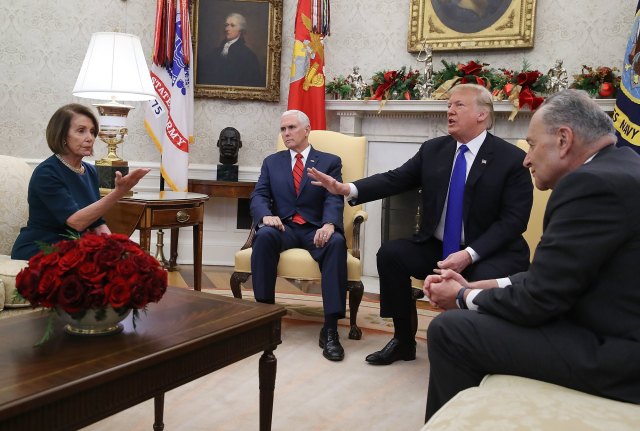Donald Trump with the Senate Minority Leader, Chuck Schumer, and the then House Minority Leader, Nancy Pelosi, with Vice President Mike Pence. Credit: Mark Wilson / Getty

President Trump is not on the ropes, but 2019 is looking tricky. Democratic control of the House promises more confrontation over policy, the likelihood of investigations, and the possibility of impeachment. The Democrats despise Trump: 77% support his impeachment and removal from office. He, too, has an equal motivation to heighten tensions. The midterms showed that he lacks majority support; to prevail in 2020, he needs an opponent he can contrast himself with much as he successfully did in 2016 with Hillary Clinton.
Tensions are already ratcheting up. But there is an alternative path. Trump still holds the high ground because as President he can set the national agenda at will. So why not offer some olive branches? It’s not that outlandish a suggestion. He could surprise the opposition while also potentially improving outcomes for the country – and himself. Here are five areas where he might find compromise.
Trump’s first olive branch would involve his beloved wall. Already he’s signalling flexibility on the barrier’s nature, saying it could be made of steel rather than concrete. The Democrats, for all their bluster, know they need to demonstrate that they care about securing the border with Mexico, even as they fight the construction of a 2,000-mile long barrier. Using the standoff to produce a comprehensive border control plan, one that includes funds for some type of barrier as well as other methods favored by Democrats, could be the surprise end for a showdown most observers think will end with Trump caving in.
The annual State of the Union speech to Congress would be the second opportunity where Trump could change his stripes. Scheduled for January 29, this is where the President traditionally lays out his agenda and frames the coming year’s debate. Some nod to bi-partisanship will be expected because of the Democratic House takeover. But if he were to go significantly further than that, calling for perhaps bi-partisan commissions to address national topics such as immigration, our massive budget deficit, or the mismatch between our foreign commitments and our military capabilities, he would confound expectations that 2019 will be business as usual.
Trump’s third olive branch could involve a longstanding Democratic priority: combatting climate change. A carbon pricing scheme would be dead on arrival because of Republican opposition, but why not instead try to spur innovation directly, rather than indirectly, as carbon pricing would do? I’ve long thought that the NASA model – which captured the nation’s imagination and launched our space research and flight programme – would fit an American-style solution for climate policy. Asking Democrats and Republicans to help Trump design and finance a National Environment and Energy Security Agency (NEESA) to drive the technological breakthroughs necessary to make carbon-free wealth creation a reality would be totally unexpected, and very hard for Democrats to ignore.
Cabinet officials could be another realm for the surprise pivot. Two slots, Defense and Interior, must be filled early in the year. Would a Democrat be a potential pick for either? Presidents often have a member or two from the opposite party in their Cabinets, so perhaps nominating the Montana Governor Steve Bullock or the recently defeated North Dakota Senator Heidi Heitkamp for Interior would be a low-cost way of building bridges.
Finally, Trump could make pushing his proposed infrastructure plan a top priority. It has languished in Congress for the past two years because spending more money, and perhaps raising gasoline taxes to pay for it, was not something Congressional Republicans wanted to do. Pushing this to the forefront now, however, would place Senate Republicans on the spot. Do they really want to say no to a programme that could fix America’s roads, expand its rail network and upgrade its airports? Perhaps financing it with a “Tesla Tax”, a per-mile charge applicable to low-emission vehicles that currently don’t pay much for the roads they use, would make a big-spending package palatable to the Republican rank-and-file.
Trump would need to make clear that this co-operation depends on reasonable behaviour from Congressional Democrats. They won’t get NEESA, bipartisan spending deals and the like if they use their new perch to launch all-out war on the White House. Normal political gamesmanship is one thing, but political persecution would mean all bets are off.
Should Trump try this or something similar, Democrats will find themselves in a quandary. Do they give in to their base, which wants Trump’s head on a silver platter more than anything? Or do they play more to the middle, the former Republicans whose anti-Trump votes gave the Democrats their House majority to begin with?
Should they choose the base, and Trump successfully turns over a new leaf, they might find they lose everything in 2020. But should they choose to co-operate, they could find they secure their image as a responsible, centre-left party capable of governing without frightening the nation.
People often underestimate Trump, thinking that he is incapable of strategic manoeuvering and change. Maybe they’re right. But what it they’re not? What if he, instead, follows the great ancient Chinese strategist Sun Tzu, who counselled that “the whole secret lies in confusing the enemy, so that he cannot fathom our real intent”?
Offering olive branches is the last thing the Democrats will expect. But it could reduce the partisan infighting that poisons America – and secure his re-election.










Join the discussion
Join like minded readers that support our journalism by becoming a paid subscriber
To join the discussion in the comments, become a paid subscriber.
Join like minded readers that support our journalism, read unlimited articles and enjoy other subscriber-only benefits.
Subscribe